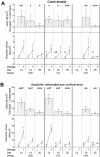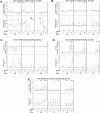Microdamage repair and remodeling requires mechanical loading
- PMID: 19821772
- PMCID: PMC3153328
- DOI: 10.1359/jbmr.091016
Microdamage repair and remodeling requires mechanical loading
Abstract
Bone remodeling is necessary to avoid microdamage accumulation, which could lead to whole-bone failure. Previous studies have shown that this bone-repair mechanism is triggered by osteocyte apoptosis. Through the use of a rodent hindlimb suspension model and tibial four-point bending model, the effects of disuse on microdamage remodeling was examined. At day 0, male rats were assigned to one of three groups: weight bearing (WB), hindlimb suspension (HS), or hindlimb suspension with daily intermittent weight bearing following damage-inducing loading (HW). Within each group, the rats were further divided into subgroups corresponding to three sacrifice time points [day 14 (WB and HS only), day 18, or day 35]. At day 14, animals were anesthetized, and their left tibiae underwent cyclic four-point bending to produce fatigue-induced microdamage. At sacrifice, the tibiae were examined using 3D micro-computed tomography (microCT), flow cytometry, and histologic and immunohistochemical stains. The results indicate that only the WB and HW groups had a significant increase in intracortical TRAP-positive resorption pits following damage induction, which was paralleled by a significant decrease in microdamage over time in combination with a shift in the osteoclast lineage owing to a decrease in monocytes. These results demonstrate that osteocyte apoptosis may be insufficient for repair of microdamage without the stimulation provided through physiologic loading. In addition, this potentially could have clinical implications for the current therapeutic paradigm for treating stress fractures, where extended non-weight bearing is employed.
Copyright 2010 American Society for Bone and Mineral Research.
Figures




Similar articles
-
Intracortical remodeling in adult rat long bones after fatigue loading.Bone. 1998 Sep;23(3):275-81. doi: 10.1016/s8756-3282(98)00104-5. Bone. 1998. PMID: 9737350
-
Mechanical loading: biphasic osteocyte survival and targeting of osteoclasts for bone destruction in rat cortical bone.Am J Physiol Cell Physiol. 2003 Apr;284(4):C934-43. doi: 10.1152/ajpcell.00234.2002. Epub 2002 Dec 11. Am J Physiol Cell Physiol. 2003. PMID: 12477665
-
Spatiotemporal Distribution of Linear Microcracks and Diffuse Microdamage Following Daily Bouts of Fatigue Loading of Rat Ulnae.J Orthop Res. 2019 Oct;37(10):2112-2121. doi: 10.1002/jor.24391. Epub 2019 Jun 29. J Orthop Res. 2019. PMID: 31206769
-
Biological underpinnings of Frost's mechanostat thresholds: the important role of osteocytes.J Musculoskelet Neuronal Interact. 2010 Jun;10(2):128-35. J Musculoskelet Neuronal Interact. 2010. PMID: 20516629 Review.
-
Bone microdamage: a clinical perspective.Osteoporos Int. 2009 Aug;20(8):1299-308. doi: 10.1007/s00198-009-0899-9. Epub 2009 Mar 17. Osteoporos Int. 2009. PMID: 19291343 Review.
Cited by
-
Gradient fluid shear stress regulates migration of osteoclast precursors.Cell Adh Migr. 2019 Dec;13(1):183-191. doi: 10.1080/19336918.2019.1619433. Cell Adh Migr. 2019. PMID: 31131719 Free PMC article.
-
Aged male rats regenerate cortical bone with reduced osteocyte density and reduced secretion of nitric oxide after mechanical stimulation.Calcif Tissue Int. 2014 May;94(5):484-94. doi: 10.1007/s00223-013-9832-5. Epub 2013 Dec 27. Calcif Tissue Int. 2014. PMID: 24370615 Free PMC article.
-
Self-repair of rat cortical bone microdamage after fatigue loading in vivo.Int J Endocrinol. 2013;2013:321074. doi: 10.1155/2013/321074. Epub 2013 Apr 10. Int J Endocrinol. 2013. PMID: 23662102 Free PMC article.
-
Osteocyte: the unrecognized side of bone tissue.Osteoporos Int. 2010 Sep;21(9):1457-69. doi: 10.1007/s00198-010-1194-5. Epub 2010 Mar 4. Osteoporos Int. 2010. PMID: 20204595 Review.
-
Age and Gender Estimation Using the Osseous Microanatomy: Original Research.J Pharm Bioallied Sci. 2024 Feb;16(Suppl 1):S233-S235. doi: 10.4103/jpbs.jpbs_474_23. Epub 2024 Feb 29. J Pharm Bioallied Sci. 2024. PMID: 38595368 Free PMC article.
References
-
- Riggs BL, Melton LJ., 3rd The worldwide problem of osteoporosis: insights afforded by epidemiology. Bone. 1995;17:505–511S. - PubMed
-
- Verborgt O, Gibson GJ, Schaffler MB. Loss of osteocyte integrity in association with microdamage and bone remodeling after fatigue in vivo. J Bone Miner Res. 2000;15:60–67. - PubMed
-
- Verborgt O, Tatton NA, Majeska RJ, Schaffler MB. Spatial distribution of Bax and Bcl-2 in osteocytes after bone fatigue: complementary roles in bone remodeling regulation? J Bone Miner Res. 2002;17:907–914. - PubMed
-
- Burr DB, Martin RB, Schaffler MB, Radin EL. Bone remodeling in response to in vivo fatigue microdamage. J Biomech. 1985;18:189–200. - PubMed
-
- Bentolila V, Boyce TM, Fyhrie DP, Drumb R, Skerry TM, Schaffler MB. Intracortical remodeling in adult rat long bones after fatigue loading. Bone. 1998;23:275–281. - PubMed

